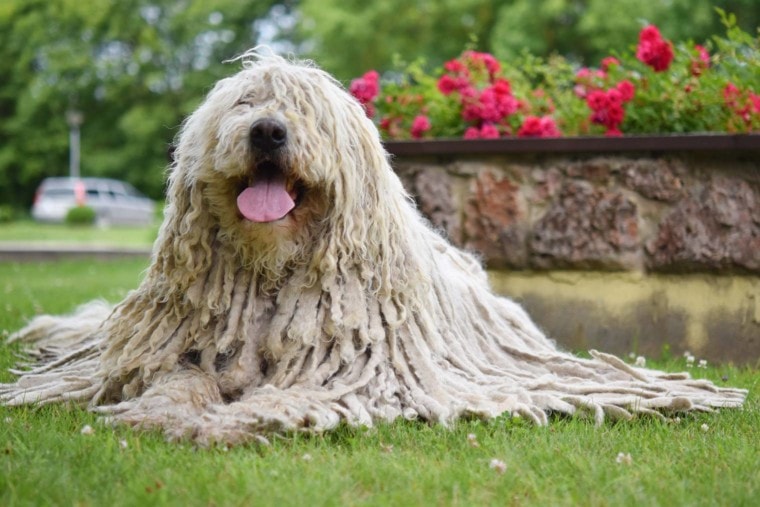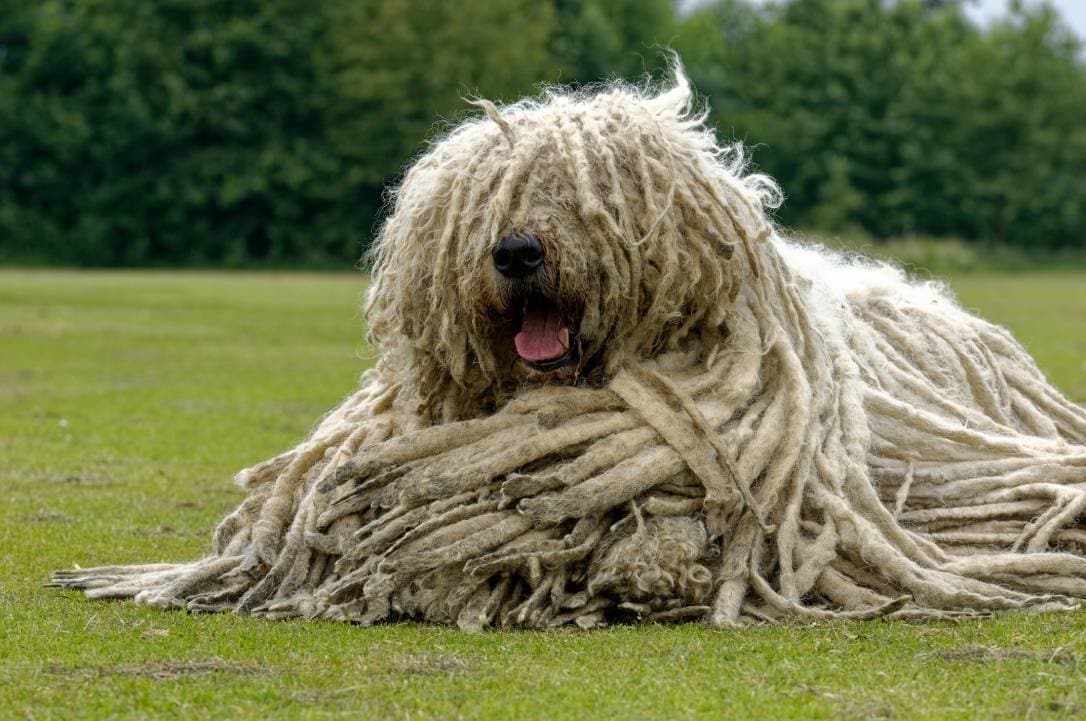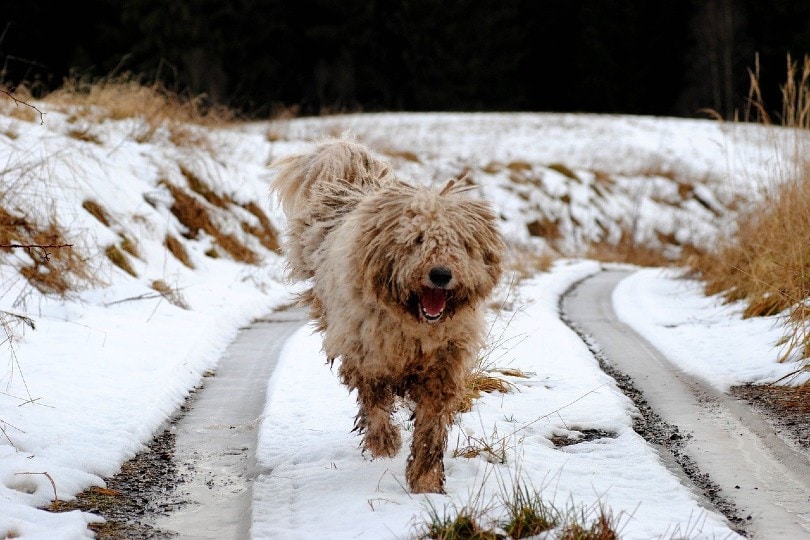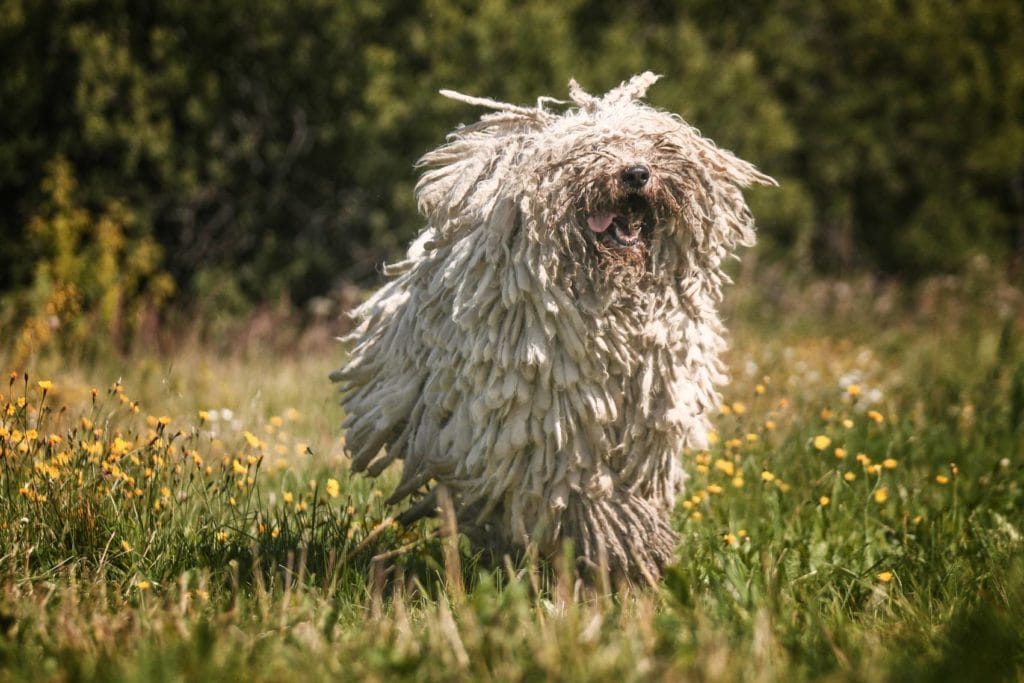
Click Below to Skip Ahead
The Komondor is a Hungarian dog breed that was developed to protect livestock. They are a unique breed in that they have white cords of hair instead of fur on their body. These are dogs that love their families, but they have an independent nature that requires firm yet loving leadership. Komondors are large in size — males can be as tall as 30 inches and as heavy as 130 pounds! Females are a bit smaller, but not by much.
Breed Overview
Height:
25–30 inches
Weight:
80–130 pounds
Lifespan:
10–12 years
Colors:
White
Suitable for:
Experienced dog owners, adventurous families, farms, and ranches
Temperament:
Protective, curious, strong, loyal, active
These dogs enjoy spending time indoors if they get enough exercise outside. However, they happen to be great escape artists, so they require tall fencing if left outside unsupervised. Here is everything else that you need to know about the Komondor.
Komondor Characteristics
 Komondor Puppies
Komondor Puppies

Komondor puppies are small and adorable, but it does not take long for them to grow large and strong. You should know about things like the dog’s energy levels, trainability, and sociability so you understand what to expect as you raise your new Komondor puppy.
These dogs need plenty of space to run around and burn their energy off. They’re not a good fit for people living in apartments or for first-time dog owners. They need plenty of mental and physical stimulation to avoid boredom and to grow into happy and healthy dogs.
Temperament & Intelligence of the Komondor
These large, protective dogs are fun-loving and curious, but they will take over as “pack leader” without a strong leader to follow at home. Komondors are extremely confident and will not easily back down from a confrontation. They love to go on long walks and hikes, and they live for adventures like camping. While these are active dogs, they know how to spend time lounging around in the house while watching their human companions go about life.
Komondors are highly intelligent and take well to training. They will use their intelligence to get their way if someone is not there to lead them. They can be left alone at home, but only for short stints at a time unless they are kept outdoors within a well-fenced yard.
Are These Dogs Good for Families? 👪
These dogs can be good with children, but they must learn how to properly interact with them while they are still puppies. They should always be supervised when around small children because they could accidentally cause accidents and injuries due to their large size. Older children should be taught all the commands that their pet Komondor knows so they can maintain control when spending time together. Komondors can get along well in large family settings, but they should be exercised outdoors daily, or they can become unruly and destructive while inside.
Does This Breed Get Along With Other Pets?
Komondors may get along with other dogs or cats if they start living with them while still young puppies. However, they are known for taking on coyotes and other fierce predators, so they have no problem taking on other dogs or strangers that they perceive to be threats. Most Komondors will see strange dogs that they see on the street or in the park as threats.
Therefore, these dogs should be socialized with other dogs and people often while still puppies and throughout their lives. Some may never learn how to meet strange dogs and get along with them, so owners should not expect to be able to easily visit the dog park.

 Things to Know When Owning a Komondor
Things to Know When Owning a Komondor
Owning a Komondor comes with a great deal of responsibility. You must know things such as what to feed your new dog, how much exercise they should get, what kind of training to incorporate, and the health conditions to look out for.
Food & Diet Requirements 🦴
These large dogs know how to eat! They can eat anywhere from 3.5 to 4 cups of dry commercial food (or the equivalent of wet food) each day, even if they are not extremely active. Their food should consist of high-quality animal protein, such as chicken, fish, beef, and turkey. Whole grains such as brown rice, and starchy veggies like sweet potatoes should also be present.
Greens, peas, and carrots are great additions. What the food should not include are fillers like corn and soy and artificial ingredients of any kind. These dogs need plenty of clean water to drink throughout the day, especially when spending time outdoors.
Exercise 🐕
Komondors are designed for outdoor work that is almost never-ending. Therefore, these dogs are used to getting plenty of exercise every day. They should get out for walks of at least 30 minutes every day, and they should have an opportunity to freely run around and explore a few times a week. When stuck indoors due to weather, these dogs can get exercise with interactive toys and through games with their human companions, such as hide-and-seek.

Training 🎾
Training is a necessity for the Komondor. These large dogs are intelligent yet strong-willed. Without obedience training in place, your Komondor can quickly take over the household as if they are in charge of everything. Obedience training should begin as soon as you bring your new Komondor puppy home for the first time. If you do not have experience with training, it is a good idea to work with a professional trainer until you are confident in your abilities to maintain effective training habits as time goes on.
Grooming ✂️
The coat on this purebred dog makes grooming easy on owners. Their cords should never be combed or brushed, but they may require the occasional trimming. It is a good idea to look through the cords to remove any debris that gets stuck in them (common for dogs that spend time outdoors).
They may require bathing sometimes because dirt and mud tend to make their white cords look dingy as time goes on. They should not need nail trimming, because being outdoors should keep them naturally short and smooth. Any other grooming requirements should be taken care of by the dog themselves.

Health and Conditions 🏥
While these dogs tend to maintain good health throughout their lives, there are certain conditions that they can develop. Owners should know about these so a plan can be made for dealing with the conditions should they develop.
Male vs. Female
There are just a few differences to note between male and female Komondors. First, males tend to be taller and heavier than their female counterparts. Second, females are known to be better at obedience training, and males are a little more independent. However, for the most part, both sexes are strong, intelligent, loyal, and protective.
3 Little-Known Facts About the Komondor
1. They Are Awesome Watchdogs.
Since these dogs have been raised to protect livestock, they have a natural tendency to become protective over their families and households. When these dogs spend time on their property, they will keep a lookout for strangers and other animals that get too close. They will be sure to alert anyone who will listen that something is not right around the property.
2. Their Coat Traditionally Served as Camouflage.
The reason that this breed’s coat looks the way that it does is for camouflage reasons. When protecting a flock of sheep, the Komondor blends right in and becomes hard to detect by predators. This makes it possible for the dog to lurch into action and catch a predator off guard, giving the dog a better chance of fighting off the predator.
3. This Breed Was Featured on a Famous Album Cover.
The Komondor was featured on the cover of Beck’s 1996 album, “Odelay.” The cover shows a Komondor gliding over a high jump with their cords flailing in the wind. The album features popular songs such as “Devil’s Haircut” and Where’s It At.”
 Final Thoughts
Final Thoughts
Komondors are massive, interesting, and good-looking dogs. They are not for the inexperienced, and they would not do well in an apartment setting. However, if you have experience raising dogs and you have a home or farm on a fenced property, this breed may be an awesome pet option for you.
Featured Image Credit: Everita Pane, Shutterstock
 Komondor Puppies
Komondor Puppies
 Final Thoughts
Final Thoughts




